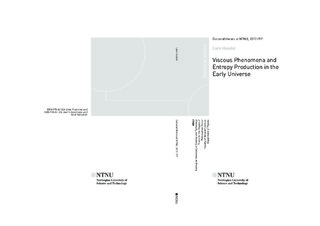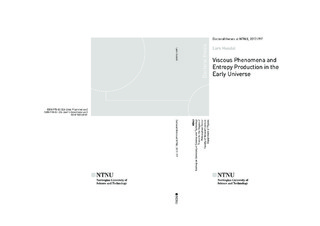| dc.contributor.advisor | Andersen, Jens | |
| dc.contributor.advisor | Myrheim, Jan | |
| dc.contributor.author | Husdal, Lars | |
| dc.date.accessioned | 2017-07-20T08:31:45Z | |
| dc.date.available | 2017-07-20T08:31:45Z | |
| dc.date.issued | 2017 | |
| dc.identifier.isbn | 978-82-326-2467-6 | |
| dc.identifier.issn | 1503-8181 | |
| dc.identifier.uri | http://hdl.handle.net/11250/2449118 | |
| dc.description.abstract | During the very first fraction of a second after the Big Bang, the Universe were populated by all the particles in the Standard Model of elementary particles: From the massive top quark to the massless photons and gluons. At very high temperatures all these particles were produced and annihilated at the same rate, and there were as many of one particle type as the next. As the creation of the massive particles requires high temperature, this would not last.
One of my papers addresses the degrees of freedom related to the elementary particles, and show the evolution of these as the universe expands and cools. As the temperature decreases the particles will go from relativistic velocities to semi- and non-relativistic velocities, before finally disappearing. The temperature at which this happens depends on the particles masses. One important difference between relativistic and non-relativistic particles is that they cool at different rates. If we have a mixture of both types a bulk viscous effect will arise, resulting a heat transfer between the two components.
Bulk viscosity and entropy production are at their highest at the end of the lepton era, just before the neutrinos decouple. At this time the neutrinos have a very long mean free path, resulting in large momentum transfers and heat exchange. The lepton era were a stage when Universe consisted of electrons, positrons, neutrinos, and photons. At higher temperatures, hadrons and eventually quarks and gluons make up a significant contribution. I have made a model universe where all particles except the leptons and photon are excluded. I can thus include the heavier cousins of the electron --- the muon and tau. By doing this, we get a more qualitative picture of what happens as particle species goes from relativistic velocities to semi- and non-relativistic temperatures and finally disappears one by one. | nb_NO |
| dc.language.iso | eng | nb_NO |
| dc.publisher | NTNU | nb_NO |
| dc.relation.ispartofseries | Doctoral theses at NTNU;2017:197 | |
| dc.relation.haspart | Paper 1:
Husdal, Lars.
On Effective Degrees of Freedom in the Early Universe. Galaxies 2016 ;Volum 4.(4)
This is an open access article distributed under the Creative Commons Attribution License which permits unrestricted use, distribution, and reproduction in any medium, provided the original work is properly cited (CC BY 4.0).
https://doi.org/10.3390/galaxies4040078 | |
| dc.relation.haspart | Paper 2:
Husdal, Lars.
Viscosity in a lepton-photon universe. Astrophysics and Space Science 2016 ;Volum 361.(263)
- Is not included due to copyright available at
https://doi.org/10.1007/s10509-016-2847-4 | |
| dc.relation.haspart | Paper 3:
Husdal, Lars; Brevik, Iver Håkon.
Entropy production in a lepton-photon universe. Astrophysics and Space Science 2017 ;Volum 362.
- Is not included due to copyright available at
https://doi.org/10.1007/s10509-017-3023-1 | |
| dc.title | Viscous Phenomena and Entropy Production in the Early Universe | nb_NO |
| dc.type | Doctoral thesis | nb_NO |
| dc.subject.nsi | VDP::Mathematics and natural science: 400::Physics: 430 | nb_NO |

